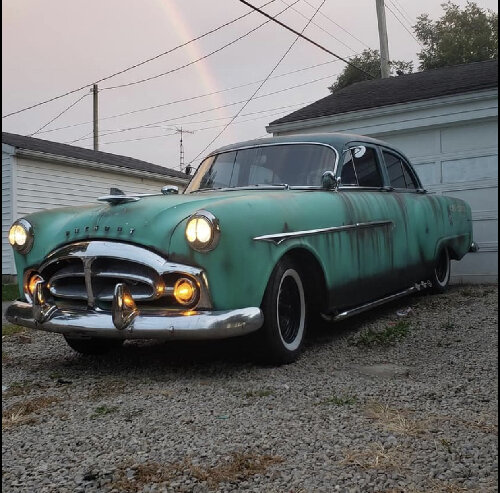|
Re: Sticky speedometer needle
|
||||
|---|---|---|---|---|
|
Home away from home
|
I don't know of a specific recommendation. One of the several vendors who services speedometers could probably advise. A watch or clock repairman might have good information.
Posted on: 5/17 7:56
|
|||
|
||||
|
Re: 1937 120 Conv. Sedan - Blanche
|
||||
|---|---|---|---|---|
|
Home away from home
|
I'd definitely stay away from ethanol, unless you are going to use it up soon. It can cause real trouble for cars in storage. "Tier One" gasolines may be more stable and of more consistent quality than "off brand" or non-branded gasoline. Aviation fuel is the best option, if available and affordable. 80 octane or above would probably suit any pre-war car. If you must store a car over 30 days or so with ethanol fuel, I'd want to use a stabilizing product and store with the tank full. Avoid any ethanol blend over 10%.
Posted on: 5/16 9:01
|
|||
|
||||
|
Re: 1937 120 Conv. Sedan - Blanche
|
||||
|---|---|---|---|---|
|
Home away from home
|
High octane fuel is not needed for pre-war cars, but it will do no harm. Staying away from ethanol-adulterated fuel is a good idea, especially for cars that are not driven regularly. High octane fuel will behave the same as regular fuel under most conditions, but it will resist detonation under high load (heat and pressure) conditions better. Those extreme conditions don't occur in normal operation of pre-war engines, so high octane fuel is not needed. Hardened valve seat inserts are not needed in pre-war cars, unless you regularly run the engine at high loads and high speeds. Leaded fuel will do no harm, but it is not required in most cases. Even "high compression" engines will run just fine on low octane fuel, * IF * high load operation is avoided. All carbureted gasoline engines are "low compression" when operating at idle and part throttle, due to higher manifold vacuum (lower manifold pressure) under these conditions. Initial compression pressures are much lower at part throttle operation, and maximum combustion heat and pressure is much lower than at wide open throttle.
Ethanol actually has a high octane equivalency, but it only has about half the BTU content (fuel value) of motor gasoline, and it "spoils". It can decay and destroy fuel systems, and it will reduce power output at higher blends. A 10% ethanol blend might be expected to reduce maximum engine power and mileage by 3 to 5% compared to straight gasoline of good quality. Blends over 10% are known to cause a number of problems in systems not specifically designed for them. In my opinion, burning food in a hungry world is beyond absurd. Beyond that, the true price of ethanol as produced in the USA is very high. There are no net benefits to using corn-based ethanol as motor fuel.
Posted on: 5/16 7:52
|
|||
|
||||
|
Re: '37 120 Horn button Removal
|
||||
|---|---|---|---|---|
|
Home away from home
|
It feels like a stop. If it's debris, it's very hard. I'm going to try blowing compressed air behind the button. It turns freely, but only a small fraction of a turn, so something is out of order.
Posted on: 5/15 14:03
|
|||
|
||||
|
Re: Auto City Classics 1951-1956 Packard OE Finish Steel Gas Tank TS5156PKQ
|
||||
|---|---|---|---|---|
|
Home away from home
|
I would add jam nuts or self locking nuts on the gas tank straps. The hardware may need re-tightend after the car has run a hundred miles or so.
Posted on: 5/15 11:36
|
|||
|
||||
|
Re: Condensers for 1941 120
|
||||
|---|---|---|---|---|
|
Home away from home
|
The electrical value of the condenser affects ignition point life and ignition performance. I think most 6 volt application condensers will work OK on most any 6 volt system, but matching the original value as closely as possible will give best results. Old condensers can leak current through their insulation or dry out and change value. A fresh condenser of the correct value is best, if one is obtainable. Condensers can be checked for leakage with an analog ohm meter and some idea of their capacitance can be determined by how long one takes to "charge".
Posted on: 5/15 11:31
|
|||
|
||||
|
Re: '37 120 Horn button Removal
|
||||
|---|---|---|---|---|
|
Home away from home
|
Mine moves freely, but will only turn about 3/16" before hitting a stop. It works fine, and depresses easily with no sticking or binding. When it stops turning in either direction, it feels like it is reaching the limit of travel, not binding. I think the black substance you found under your horn button was once foam rubber. I've seen it turn to a thick gummy liquid or even into a hard substance like hard black plastic.
It may be that I need a way to lift up on my horn button while turning it to the left, like a suction cup. My steering wheel is the banjo "European style", but the horn button looks exactly like yours. Thanks for the info.
Posted on: 5/15 11:23
|
|||
|
||||
|
Re: Accelerator pedal travel?
|
||||
|---|---|---|---|---|
|
Home away from home
|
Year and model of your car would be helpful. The engine should respond promptly to pressing the accelerator. Your linkage may need adjustment. With the engine off and the pedal held to the floor, the carburetor should be wide open. The throttle lever on the carburetor base that the linkage attaches to rests against the idle speed adjustment screw when in the closed position. There is a projection on the carburetor base that stops the lever's movement at full throttle. With the pedal down, the carburetor throttle lever should be against the stop.
Posted on: 5/15 7:44
|
|||
|
||||
|
'37 120 Horn button Removal
|
||||
|---|---|---|---|---|
|
Home away from home
|
My '37 120 has the optional banjo steering wheel. I need to remove the horn button to check the tightness of the steering wheel retaining nut. The horn works as it should. The horn button can be rotated easily within limits.It moves easily about 3/16" either way, and comes to a hard stop. When I push down on it, it goes down easily and comes to a hard stop. There is no indication of binding or friction, either rotating or pushing down.
Posted on: 5/15 7:37
|
|||
|
||||








